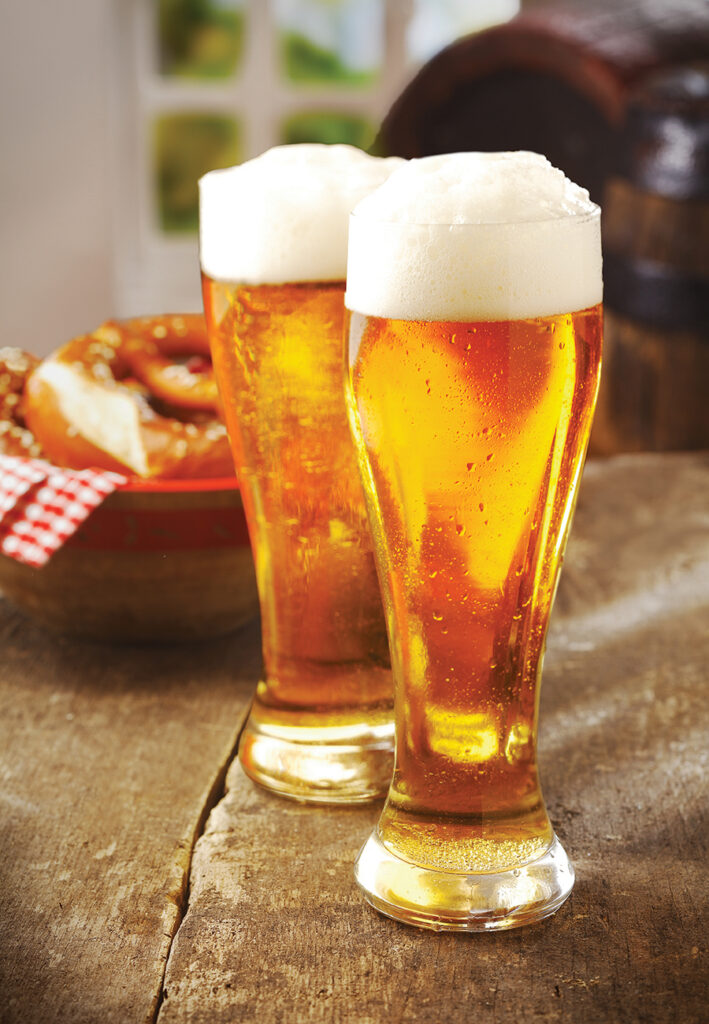Beer, one of the oldest and most popular beverages in the world, has been brewed for more than 7,000 years. Ancient Middle Eastern civilizations created early brews using barley, a grain that was readily available at the time. As brewing techniques improved, and as the Roman Empire shared assimilated knowledge from the Middle East to North Africa to England, the collective wisdom of brewing spread among European tribes and beer became an important part of religious ceremonies, daily life, and even currency.
As early adopters of the process, Germany has maintained beer prominence for centuries and is renowned for its precision and adherence to brewing traditions. Not surprisingly, German brewing techniques are the gold standard in many parts of the world.
Most beer styles fall into two main families, ales and lagers.
Ale
Known for diverse flavors, ales are brewed at warm temperatures using top-fermenting yeast.
Most popular ale types are part of the British brewing tradition, integrated from the Romans’ in the first century. By the time England had its own empire, hops-based pale ales had been developed and were being exported to England’s many colonies, which meant British tastes had some influence on brewing worldwide. India Pale Ale (IPA) was created specifically to withstand long sea voyages to colonial India.
Porters & Stouts
Named for its popularity among porters and other laborers in the city, porter was the solution for London brewers wanting to create a drink that was more robust and satisfying than the ales of the time.
Initially referred to as a “stout porter,” stout beer eventually developed its own identity. It is recognized by its dark color, which comes from using roasted barley during the brewing process. It typically has flavors of roasted malt, chocolate, coffee, and hints of smoke, and a smooth texture that comes from adding nitrogen—which creates smaller bubbles—during the carbonation process.
Guinness, the world’s most famous stout, was established in 1759 by Arthur Guinness in Dublin, Ireland. It is famous for its deep black color, creamy texture, and rich flavors of roasted malt and coffee, and has become an iconic symbol of Irish culture.
Stouts pair well with hearty dishes like stew, roasted meat, and chocolate desserts.
American Ale
The American craft beer revolution, which began in the 1970s, has been fostering an explosion of ale diversity, creativity, and experimentation.
American Pale Ales, India Pale Ales (IPAs), and stouts with unique flavor profiles have gained global popularity because American craft brewers are best known for pushing boundaries with innovative ingredients, resulting in exciting and unconventional brews. Ale fans benefit from their ingenuity and willingness to incorporate exotic ingredients like coffee, fruits, spices, chocolate, and even bacon to add complexity and create new flavor profiles.
Lager
Lagers come in many varieties and tend to highlight the malt character. They are fermented using yeast strains that work efficiently at cooler temperatures and settle at the bottom of the vessel, resulting in a lighter color and a mild, crisp taste. After fermentation, the liquid undergoes a process called lagering, during which it is aged at near-freezing temperatures for up to several months.
Lagers played a significant role in the implementation of the German Beer Purity Law, or Reinheitsgebot, in 1516. The law mandated that beer could only be brewed using water, barley, and hops (later expanded to include yeast). This focus on simplicity and quality helped shape the lager style and its reputation for purity and their approachable flavor profiles and versatility historically made lagers a preferred choice for beer drinkers worldwide.
In the mid-19th century, German immigrants brought the lager brewing tradition to the United States. This gave rise to American lagers, such as the iconic and perennially favorite Budweiser and Coors brands.
Pilsner
Pilsner is one of the most popular sub-styles of lager. It originated in the Czech town of Pilsen in the 19th century and quickly gained popularity. It is known by its pale golden color, crispness, and distinctive hop bitterness, which are benchmarks for the lager style.
With so much German influence in Texas, it is no surprise that the Lone Star state has adapted its own beer tradition with bock lagers. Bock beers are malt-forward and typically take on a deep copper to dark brown color.
They have a full-bodied and mildly sweet flavor profile, thanks to infusions of toffee, caramel, toasted bread, or a hint of chocolate, and a slightly higher alcohol content than traditional German lagers. Their robust flavors make them a good pair for bold Texas cuisine, which adds to their popularity in the state.
Sour Beers
Sour beers date back centuries and today offer a departure from traditional beer flavors. They have gained popularity in recent years due to their unique and complex flavors. Unlike traditional beers, it is intentionally soured by adding microorganisms that produce lactic acid and other compounds. These offer a wide range of flavors, from mildly tart to intensely sour. The acidity can reflect the tartness of lemons, cherries, or green apples. Some also incorporate wild yeast strains and exhibit funky, earthy, or barnyard-like flavors.
Each beer in this family has unique characteristics and many are aged in oak or wine barrels. Barrel aging contributes additional complexity, as the beer interacts with the wood and any residual microorganisms or flavors present in the barrel, adding depth and character to the final product.
Cheers

The world of beer is a diverse place with a wide variety of types and styles to explore. From classic, traditional, and centuries-old brewing traditions to innovative and boundary-pushing craft brews, there is something to suit every beer enthusiast’s palate this summer as they embark on a delightful journey of taste, appreciation, and exploration. Cheers to the remarkable diversity and endless possibilities found within the wide and wonderful world of beer!
